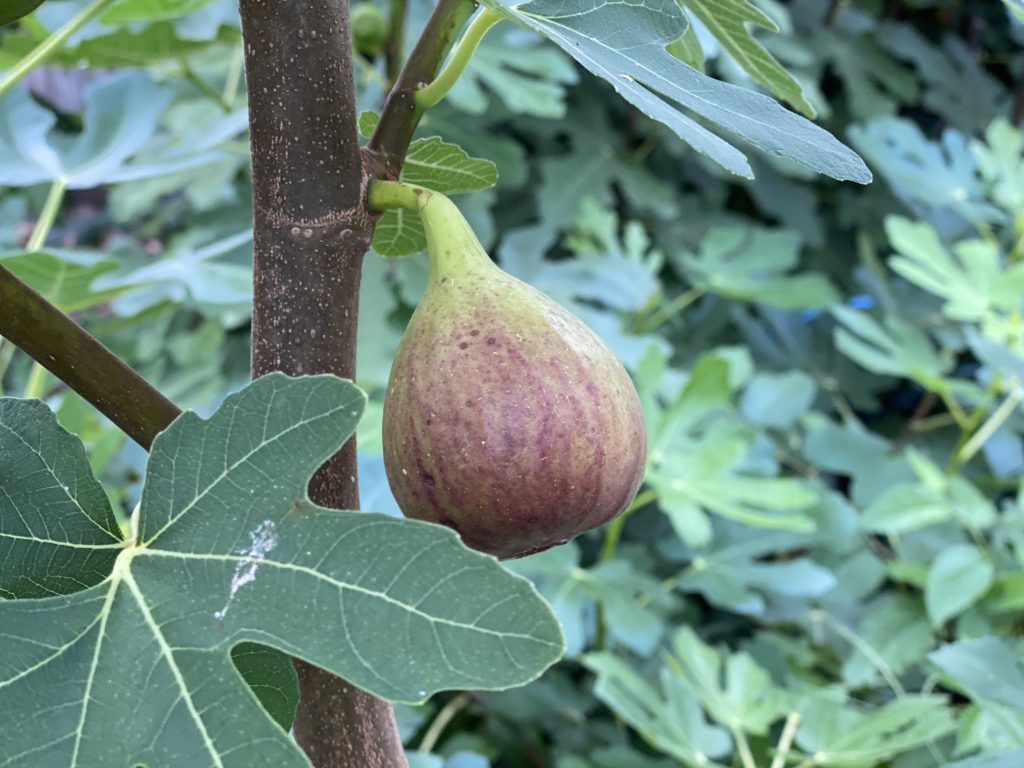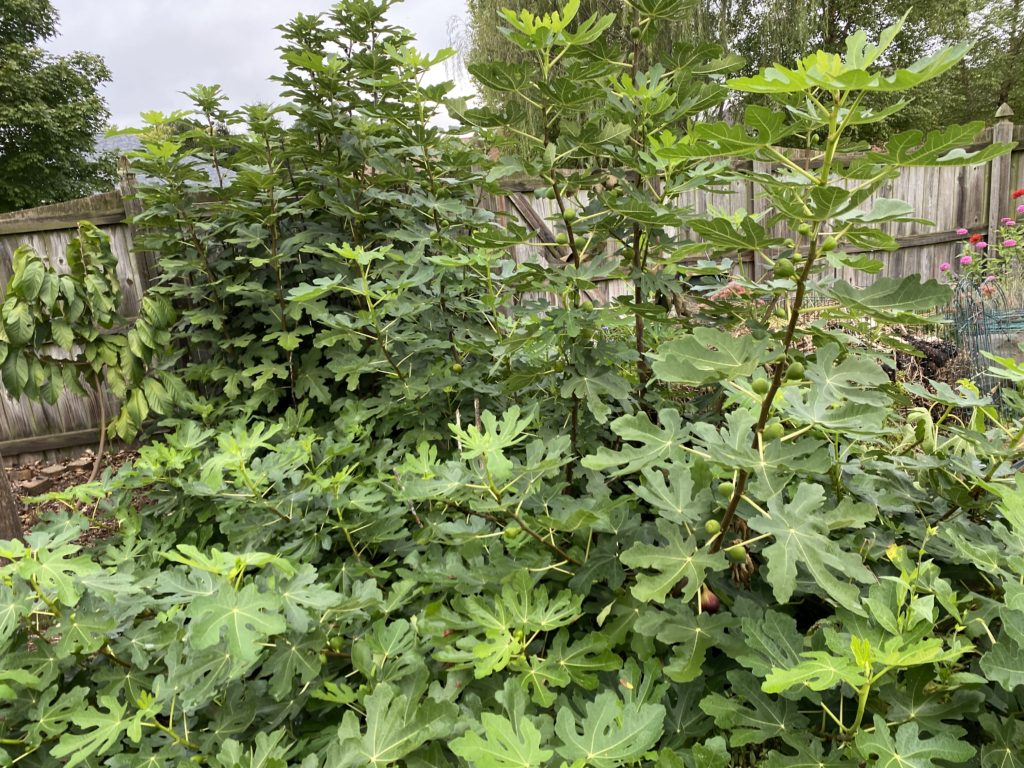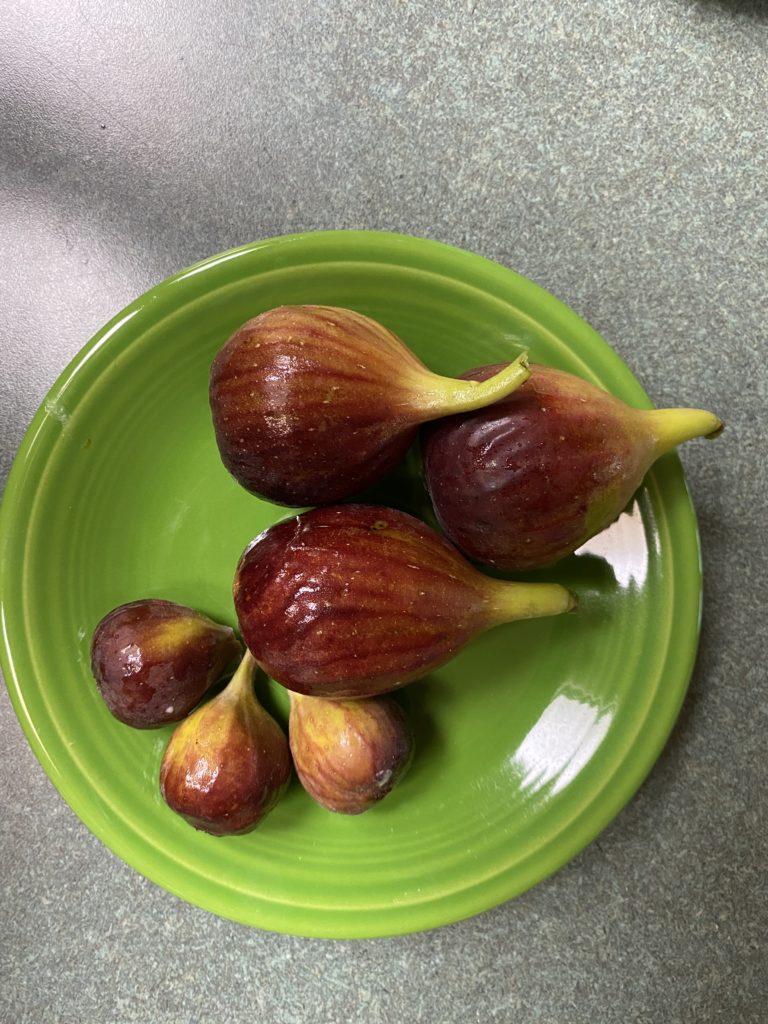Yes, I successfully grow figs outdoors in central Indiana, USDA Hardiness Zone 6a.

I grow my figs in the ground. I don’t dig them up in the fall to move them inside or lay them in a trench to protect them from the cold. I don’t keep them in containers and move them into the garage in the fall. That would be a lot of work!
They are in the ground. And that’s where they stay.
The only thing I do that is the least bit special is cover the base of the plant with a big heap of chopped-up leaves in late fall, after we’ve had a killing frost. The top growth then dies back during the winter.
Late in the spring, when we are close to frost-free, I remove the chopped-up leaves from the base of the plant. Then I cut back the branches to the first little green buds coming out, which are generally at the base of the plant, ground level.
Then the fig plants grow and in one season I end up with giant plants that are six to eight feet tall and just as wide with bunches of figs that I hope ripen before the first frost.
I took this picture on September 21st along with the picture above of a nearly ripe fig.

There are two figs in this picture. The big, spreading, wide fig in front is the variety ‘Brown Turkey’. The tall fig in the back by the fence is ‘Chicago Hardy’.
If I wanted a variety that grows more up than out, I’d choose ‘Chicago Hardy’. If I was more interested in the figs, I’d choose ‘Brown Turkey’.
Why? My experience is that ‘Brown Turkey’ figs are much bigger than ‘Chicago Hardy’ and they tend to ripen earlier, too, which means they usually ripen before the first frost. Though this year, both are ripening at about the same time, which allows me to show you the difference in fig size.

In the above picture, the big figs are ‘Brown Turkey’. The little figs are ‘Chicago Hardy’.
Both fig plants have been in the ground for at least five years.
My sense is that it is probably better to plant a fig plant in the spring to give it a chance to grow good roots before winter sets in, but, I actually planted ‘Brown Turkey’ one fall day after buying it on clearance at a local garden center. I planted ‘Chicago Hardy’ in the spring. So I don’t think it really matters when you plant them. Just cover the base with leaves in late fall.
The only other thing I have to say about figs is actually an apology to the author Fannie Flagg who wrote in the beginning of her novel, Can’t Wait to Get to Heaven, that octagenarian Elner Shimfissle fell off a ladder after climbing up it to reach her figs and getting tangled up with a wasp’s nest. I remember thinking there is no way a fig plant would get so tall in Missouri—where the fictional town in the novel was—that Elner Shimfissle or anyone would need a ladder to reach them.
Well, I guess I was wrong. This year, I almost need a ladder to reach the tops of my fig plants. Almost. So sorry to doubt you, Fannie Flagg!
By the way, if you want to read more about figs and wasps, I recommend Gods, Wasps, and Stranglers: The Secret History and Redemptive Future of Fig Trees by Mike Shanahan. Read it and you will never look at a fig again without wondering about the wasp inside.
And that’s pretty much all I have to say about my figs. Feel free to leave a comment if you have any other questions about how I grow figs in my USDA Hardiness Zone 6a garden.

Brief book update: All signed copies of my gardening humor books, all covers, are now available via my online store. Hardbacks $22, Softcovers $12. That’s $3 off the cover prices. I also have a limited number of copies of The Christmas Cottontail. Shop early for the holidays.

I was pleased to be a guest last Saturday on Better Lawns and Gardens hosted by Teresa Watkins. Her show airs live on Saturday mornings from 7 am – 9 am EST on WFLA-AM 540 and several other stations in Florida. Click here to listen to my segment.


so enjoyed your article on Jane Friedman’s website. And love this piece about figs. I live in upstate New York and did think about trying the Chicago Hardy fig, but decided against it, as I am really not zone 6 here. I write about gardening too, calling my column “Out in the Garden. ” Wonderful to find another garden blogger via Jane. Will continue to read your column with interest. Oh, and by the way, where exactly in central INdiana are you? I spent junior high and high school years in Franklin, INdiana, just south of Indianapolis.
Judith, I’m in the Indianapolis area. I go to Franklin occasionally to visit Wild Geese Bookshop, which is a great independent bookstore. And thanks for the kind words about my blog post on Jane Friedman’s website!
Thank you for sharing this! We garden in southwest Michigan, zone 6a. I bought a small Chicago Hardy seedling this spring, and planted it in a pot. It is growing happily, and even put out fruit in late August, which I snipped back. We will be putting it into the ground as soon as we can, and follow your regimen.
When you say you cover the base of the plant with leaves, approximately how deeply do you cover it?
Do you fertilize in the spring?
Thanks!
I put a good sized pile on the base, maybe a foot of leaves.
I’ve never fertilized either fig.
Hello! I’m so glad there’s hope for figs in Indianapolis! I bought two Chicago figs last spring and planted them in containers. I brought them indoors and they still haven’t come out of dormancy. They did very well over the summer, but I’m afraid that they are dead. Have yours come out of dormancy?
Kati,
I planted mine in the ground… I cover the ground around the base with lots of leaves in late fall and then as things warm up, the figs come back from the roots. I’ve had them for about 5 years. I’m not sure what that bitter cold snap around Christmas did to them but I’ll find out soon enough.
Hi Kati. This happens. I lost 4 nice fig plants that I had them indoor. After dormancy they need to be in a basement or garage. Temperature should be between 35-45 F. Water once a month. They should start blooming by end of March. I have 4 trees in the ground, got good figs last summer. So you can buy new figs and you will succeed.
Hello Carol,
A little over two years ago I wrote to you for advice about overwintering our Chicago Hardy fig growing in our garden in southwest Michigan. We followed your advice and the result is…. success! We had quite a harvest of figs late in September and October this year. Many had time to ripen on the tree. Many had to be picked green. We used the green figs in stews (after boiling in water and discarding the water to remove bitterness).
Thanks again!
Wonderful to hear back that you are having success with figs! I’ve never picked them green… is usually just let them go once I get frost. Good to know that I could…
When you say that you cut them back to the green buds in the Spring , i am envisioning how peonies die back in the winters in Michigan. Is this similar? Do you cut off everything above the green buds?
Yes it is similar to how peonies die back except, I don’t cut the figs back to the ground in the fall. I cut them back to about a foot tall and then cover that over with leaves. I remove the leaves in the spring and when I see where new growth is, I cut anything above that new growth. Hope this helps answer your question!